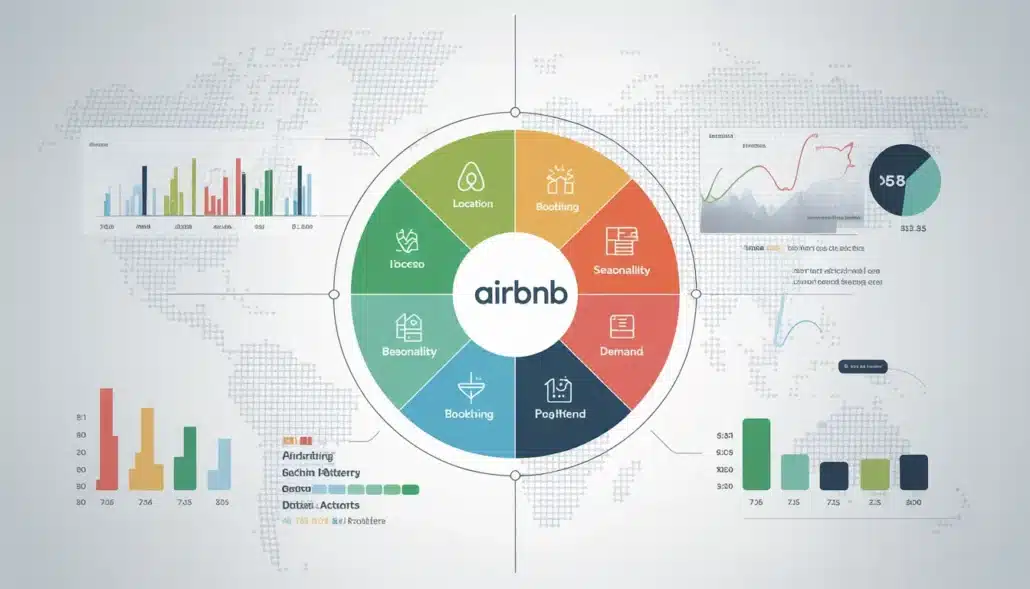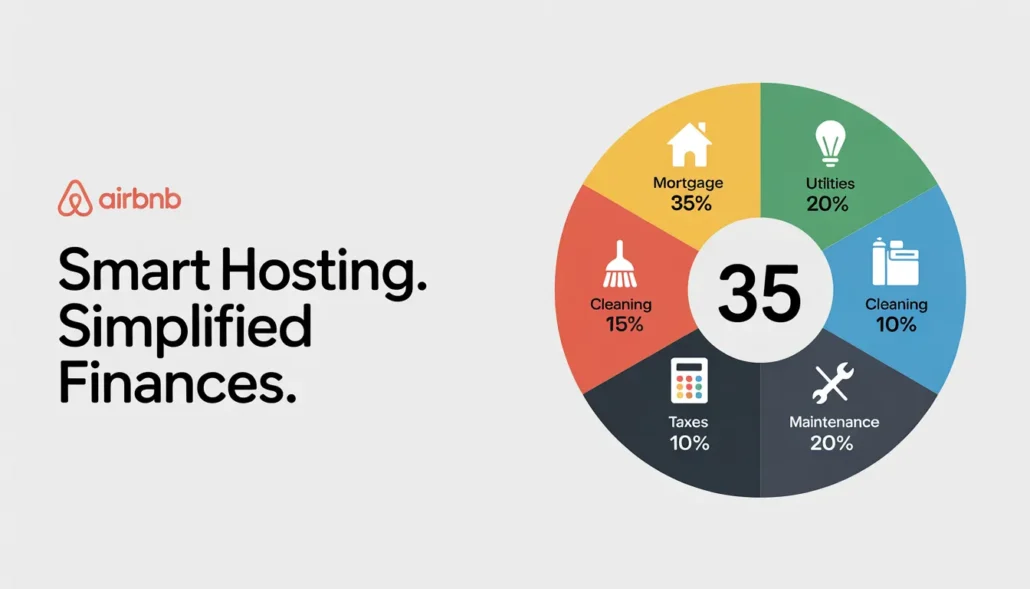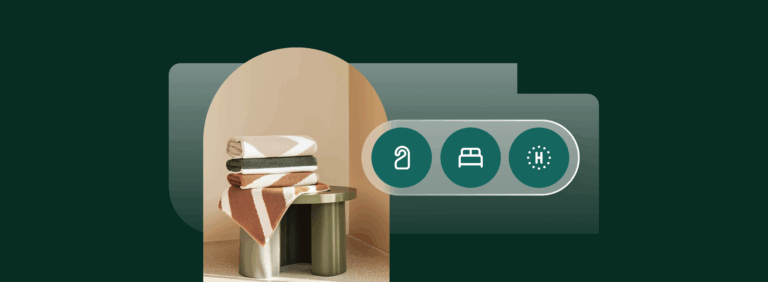Getting your Airbnb pricing strategy right is one of the most important steps to running a successful short-term rental. Price is too low, you leave money on the table. Price is too high, and you risk driving potential guests away. This guide will help you understand exactly how to price your Airbnb rental, using a step-by-step, data-driven approach that balances profitability with competitiveness.

How does Airbnb pricing work?
When you set up your listing, Airbnb suggests a nightly rate using its internal pricing algorithm. This tool analyzes key variables such as your property type, location, nearby listing trends, seasonality, and booking patterns. However, this is only a starting point — and Airbnb itself recommends not relying solely on these price tips.
For new hosts, Airbnb may suggest launching at 10–30% below the market average to gain visibility and early reviews. This strategy can help boost your listing in search results, but it must be carefully managed. The goal is to ramp up your pricing once you’ve built enough social proof through reviews and occupancy history.
Airbnb’s dynamic pricing tool updates suggested prices daily. It accounts for:
- Market demand and seasonality
- Booking window trends
- Listing performance and popularity
- Competitor availability and pricing
- Local events and holidays
You can manually override these suggestions at any time or use Smart Pricing features with minimum and maximum rate caps. However, a more powerful and host-centric alternative is Guesty PriceOptimizer — a dynamic pricing engine fully embedded into your property management system.
Studies have shown that hosts who adopt dynamic pricing strategies tend to outperform those who set static rates, with professional hosts leveraging pricing adjustments more frequently. By using a tool like Guesty PriceOptimizer, even non-professional hosts can apply pricing fluctuations to maximize revenue.
Guesty PriceOptimizer enables:
- Full market visibility with pricing predictions tailored to your listings
- Clear breakdown of original, market, and optimized pricing — all in one dashboard
- Real-time responsiveness to events, seasonality, and demand shifts
Compared to Airbnb Smart Pricing or third-party tools like Beyond Pricing, PriceLabs or Wheelhouse, Guesty PriceOptimizer provides deeper integration and more customization options, especially for hosts who manage multiple properties and want everything on one platform.

Fixed Airbnb pricing
Fixed pricing means setting one consistent nightly rate for your listing, regardless of seasonality or fluctuations in demand. This approach offers simplicity and predictability but must be carefully calculated to ensure profitability in both high and low seasons.
1. Establish a sustainable base rate
Start by identifying your monthly expenses and ideal occupancy rate (as covered in the Cost-Based strategy). Use these figures to calculate a break-even nightly rate, and then add a realistic profit margin. From there, compare your number to similar listings in your area to avoid overpricing.
2. Choose simplicity over responsiveness
Fixed pricing is ideal if your market has relatively stable year-round demand, such as cities with a strong base of business travelers, hospitals, or universities. It also works well if your listing has long-stay appeal, where guests prioritize predictable costs.
This strategy minimizes pricing maintenance, making it easier for solo hosts or those with limited time. However, without dynamic adjustments, you may leave money on the table during peak seasons or struggle to attract bookings in slow periods.
3. Compensate with discounts or promotions
To account for demand shifts without overhauling your pricing model, use promotional tactics such as:
- Monthly discounts for long-term guests
- Special offers during off-peak dates
- Weekly rates for business travelers or digital nomads
These tools provide flexibility within a fixed framework, helping you boost occupancy without constant price management.
Competitor-based Airbnb pricing
After covering your costs, the next step is market benchmarking. Competitive pricing keeps your property attractive to potential guests, especially in saturated areas.
1. Research your local market
Use Airbnb’s search filters to compare your listing to others:
- Same property type (entire home, private room, etc.)
- Similar amenities and features
- Comparable location and access to attractions
- Equivalent guest capacity
Sort results by relevance and look at listings booked 2–3 months in advance to avoid temporary discounts. This gives a clearer picture of long-term pricing trends.
Take notes on nightly rates, minimum stay policies, and cleaning fees. Pay attention to listings with consistent bookings and strong reviews — those are your true competitors.
2. Identify underserved price points
If your competitors cluster around the $100–120 range, but your property has superior amenities (e.g., a hot tub or free parking), it may justify a higher rate. On the flip side, if you lack certain features, slightly underpricing your listing may improve your conversion rate.
Look for pricing gaps: for example, properties priced too high without matching quality or too low with high demand. Position your listing within these gaps to capture missed opportunities.
Cost-based Airbnb pricing
This strategy focuses on ensuring your Airbnb listing is financially sustainable. Before setting a price, you need to calculate your break-even point and desired margin. Here’s how to break it down:
1. Calculate your operating costs
Create a detailed monthly breakdown of all fixed and variable expenses:
Fixed costs:
- Mortgage or rent payments
- Property taxes
- Insurance
- HOA or condo fees (if applicable)
Variable costs:
- Utilities (electricity, water, internet, gas)
- Cleaning fees (even if you do it yourself, calculate the value of your time or outsourced service)
- Consumables (toiletries, kitchen basics, linens)
- Maintenance and repairs
For example, if your total monthly cost is $2,400 and you want to maintain at least 80% occupancy (24 booked nights/month), your baseline nightly rate should be $100 — just to break even.
2. Add a profit margin
Once you have your minimum viable nightly rate, decide on a realistic profit margin. This should reflect:
- Market competition
- Your level of service or property uniqueness
- Time spent managing the listing
Many hosts aim for at least 20–30% above their break-even rate. Continuing the example above, that would push your nightly rate to $120–$130.
3. Include operational charges
Some costs shouldn’t be included into your nightly rate:
- Cleaning fee: Charged separately to guests; ensure it reflects actual costs.
- Security deposit: Optional, but recommended for properties with high-end furnishings or frequent turnovers. A good rule is to charge the equivalent of 1 night’s rate.
- Taxes and fees: Check your local short-term rental tax regulations. In some markets, Airbnb collects taxes on your behalf; in others, it’s your responsibility.
4. Value your time
Your time has value. Managing guest communications, handling maintenance, and coordinating turnovers adds up. Even if you’re not paying a co-host, you should factor in a time cost when calculating your desired margin.
Some hosts use a management fee model, allocating 10–15% of monthly revenue as a notional time investment. This allows you to price your listing more realistically and justify a higher rate.
5. Use LOS (Length of Stay) discounts strategically
Once your base price is established, create weekly (7+ nights) and monthly (28+ nights) discount tiers to increase occupancy. Airbnb lets you automate these. A 10% weekly and 20% monthly discount are common baselines, but adjust based on your area’s norms.
Longer stays reduce turnover costs, guest messaging, and vacancy gaps — all of which improve profit margins over time.

Value-based Airbnb pricing
Value-based pricing is all about what your listing is worth in the eyes of your ideal guest. Rather than focusing solely on costs or competitors, this strategy emphasizes unique appeal — from your design and amenities to the experience you create.
1. Highlight what makes your listing special
Guests are willing to pay more when they feel like they’re getting something memorable or premium. Aesthetic interior design, thoughtful decor, boutique hotel vibes, or location perks (like city views or beachfront access) all contribute to perceived value.
Think beyond physical features. Small touches — like handwritten welcome notes, personalized guidebooks, or complimentary snacks — can justify higher prices when marketed effectively.
2. Match pricing to experience
Once you’ve identified your property’s standout elements, make sure your pricing reflects them. Compare your space not just with similarly sized listings, but with similar guest experiences. A well-designed one-bedroom loft might reasonably charge more than a larger but generic two-bedroom apartment.
Your listing copy, photography, and reviews should all reinforce this value — showing potential guests what makes the price worth it.
3. Use reviews to strengthen perceived value
Guest reviews that mention ambiance, attention to detail, or outstanding hospitality help validate your value-based rate. If guests consistently praise the experience, you’ll build the credibility needed to maintain premium pricing — even in competitive markets.
Seasonal Airbnb pricing
Seasonal pricing helps you align your rates with demand patterns throughout the year. Instead of charging the same amount year-round, you adjust prices during high, shoulder, and low seasons to reflect real-world guest behavior.
Research shows that professional hosts tend to charge significantly more during peak season — up to 24% higher than casual hosts.
1. Identify seasonal trends in your market
Research your local area’s tourism trends, events calendar, and historical booking data. For example, ski towns see high demand in winter, while coastal or nature-driven areas often peak in summer. Urban markets may slow during holidays but spike around conferences or festivals. Many cities experience demand surges during weekends.
Your property’s demand might also change depending on whether you cater to families, remote workers, or weekend travelers.
2. Adjust rates strategically
Once you’ve mapped out your high and low seasons, update your rates to match. In peak periods, increase your prices by 10–50% to capitalize on demand. Lower rates for off-season or offer discounts to encourage occupancy.
Tiered Airbnb pricing
Tiered pricing allows you to customize your rates based on guest count, amenities, length of stay, or add-on services. It introduces flexibility while giving guests clear choices — which can lead to increased revenue per booking.
1. Set a smart base rate with add-ons
Begin by establishing a fair base rate that covers two guests. Then, layer in charges for:
- Additional guests (e.g., $15 per extra person per night)
- Pet stays
- Access to premium features (like a private sauna, pool, or rooftop terrace)
These tiers ensure you aren’t undercharging for larger groups or undervaluing unique offerings. Airbnb’s pricing settings make it easy to configure these extras automatically.
2. Incentivize longer stays
Tiered pricing also works well for offering length-of-stay (LOS) discounts. Common configurations include:
- 10% off for weekly bookings
- 20–25% off for monthly stays
This reduces turnover costs and fills calendar gaps — especially helpful in slower seasons or urban markets with remote workers.
3. Offer experience packages
For hosts who provide a hospitality-driven experience, consider building custom pricing tiers. Examples might include:
- “Standard Stay” (self-check-in, basic amenities)
- “Premium Stay” (early check-in, stocked fridge, local guidebook)
- “Luxury Experience” (concierge services, welcome gifts, spa setup)
These packaged tiers cater to different budgets and preferences while helping you upsell experiences.
Dynamic Airbnb pricing
Dynamic pricing automatically adjusts your nightly rate based on real-time market conditions. It’s one of the most powerful tools available to hosts — and when used correctly, can significantly boost your revenue and occupancy rates.
1. Understand the data driving dynamic pricing
Dynamic pricing tools analyze a wide range of variables:
- Competitor availability and pricing
- Local demand trends and events
- Lead time and booking window
- Day of the week patterns
- Seasonality and occupancy history
Rather than reacting manually to these trends, the system makes predictive adjustments to keep your rate optimized.
2. Set smart boundaries and rules
While automation handles the heavy lifting, it’s important to stay in control. Define your:
- Minimum and maximum nightly rates
- Base price
- Custom rules for high-demand weekends or last-minute bookings
This ensures your prices stay competitive without dipping below your profitability threshold.
3. Monitor performance
With dynamic pricing, the key is regular review — not daily tinkering. Most platforms let you view performance dashboards showing pricing changes, occupancy, and revenue per available night (RevPAR). Monitor this data monthly and fine-tune your settings to align with your goals.
If you’re managing multiple listings or want to reduce time spent on pricing, this strategy provides a scalable and efficient solution.
Guesty PriceOptimizer: A smarter way to automate Airbnb pricing
Explored all the key pricing strategies? Now it’s time to automate for scale. Guesty PriceOptimizer is a dynamic pricing tool built into the Guesty platform, designed to help you stay competitive without daily manual updates.
Here’s what makes it different:
- Real-time rate suggestions based on demand, seasonality, and market shifts
- Custom rules for specific days, events, or booking windows
- Built-in pricing limits to protect your minimum profit margins
- Full integration with your PMS, syncing updates across all channels instantly
Compared to Airbnb Smart Pricing or third-party tools like Wheelhouse and PriceLabs, Guesty PriceOptimizer offers a more unified workflow — ideal for hosts managing multiple listings who want pricing and automation in one place.
Final optimization tips
- Run quarterly audits of your listing’s performance using Guesty Analytics or market data
- Adjust seasonal pricing in advance based on lead time and occupancy trends
- Offer LOS discounts and early bird deals through your PMS
- Review and fine-tune weekend or event-based pricing monthly
Whether you’re just starting or scaling across multiple properties, combining competitive research with a smart, integrated tool like Guesty PriceOptimizer will elevate your Airbnb pricing strategy.




